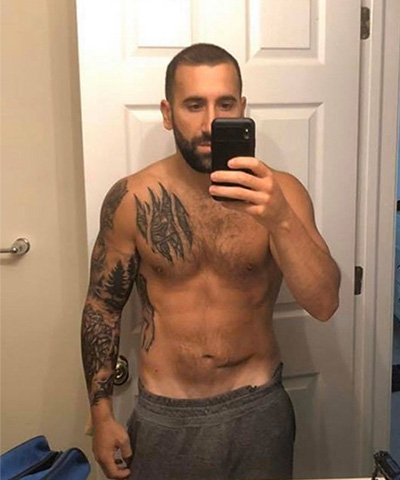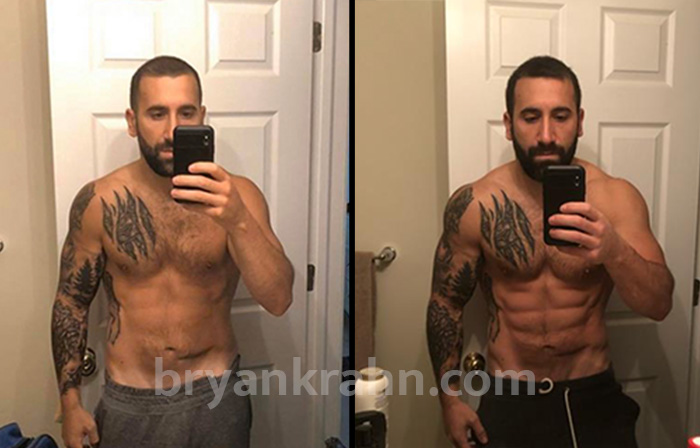I want to tell you about my client, Mike Millner, and how we handled his diet in and around his vacations and — now that we’ve got Covid-19 — how we handled his plan for the shutdown.
Mike is a bit different than your normal client, as he’s a very successful fitness professional himself.
As you can see from his “before” pic, Mike’s pretty darn advanced.
He’s not exactly filled his life with horrible habits that are pretty low-hanging fruit to fix. His “before” pic looks like an “after” pic for many.
 Mike “before”
Mike “before”
(see below for the after…)
That was, in and of itself, a challenge.
Truth is, I’d followed Mike on Instagram (@coach_mike_millner) for over a year when he reached out to me. It wasn’t until our initial call that I realized that he was someone I knew and respected.
I actually coach quite a few fellow coaches. Not because I’m so great. It’s just that (as I can myself attest) it’s damn hard to coach a lot of people and then objectively dial yourself in.
There’s a reason people need outside perspectives.
Still, I admit I find it flattering on a professional level. But also challenging, cause Mike also happens to be in great shape.
When he reached out, he said his goal was to reach all time best shape. His ballpark guesstimate was “under 10% bodyfat and 190 pounds.”
Now, bodyfat percentage has basically become a meaningless internet metric, but Mike and I were on the same page in that regard: under 10% means “very sharp upper abs, visible pelvic (hip) bones, and just a very athletic but not super-ripped” look. So that’s what we shot for.
But when we finally consulted, I quickly saw why he wanted help…
The Challenge
Mike was busy. Busy business and home life. Now add in back-to-back vacations and you can see why he wanted outsource.
Things were a little slow when we first started, mainly due to him having several vacations and the cruises.
You can vacation and not gain weight (you can even lose weight) if you’re in a good place metabolically—but going on near back-to-back vacations and cruises at the start of a diet just isn’t conducive to reaching sub-10% bodyfat.
So things plodded along, but eventually I knew we had to throw some gas on the fire.
Here’s what we did:
We started cycling daily calories for a greater net weekly deficit, with the daily “swings” in calories getting more severe.
On training days, we capped carbs at a gram per pound, around half in the pre/post-workout window and the rest spread throughout the day.
On off days we went very low carbs (50-100g), and mainly kept the sources for those carbs veggies and 1-2 pieces of fruit.
As we progressed, we didn’t cut the calories on a daily level; instead, we bumped up the number of LOW days (even if they were training days) and eventually made one of the training days a refeed day (or, in Mike’s case, an eat-your-ass-off day).
Was that level of complexity necessary? Physiologically, maybe—maybe not. But PSYCHOLOGICALLY it was what Mike needed to stay focused and engaged. Which is everything.
And it proved to be the right tool for the job. That’s all that matters in the en—
*record scratch*
…oh, and then the shutdown happened.
No more travel.
No more gym.
Mike was stuck at home.
But Mike still had goals, and he didn’t just want to put things on hold. The show must go on.
Everyone’s situation is different, and Mike’s was actually a bit better than most, but with some very real limitations. He had a few dumbbells, a barbell, weights and a bench. But, going back to the initial challenge, Mike’s also already pretty advanced guy, so although there was a lot to work with, it was nowhere near the amount of sheer weight he was used to using.
Training: Instead of starting over from scratch, I reworked his existing program such that the total amount of weight was less of a factor. For example, I raised the reps and shortened rest intervals. I added in more supersets, giant sets, and other strategies to challenge muscles and maximize tension.
Cardio: Before the shutdown, we’d never planned to do much for cardio (opting instead to focus more on weight training), but in light of the drop in movement caused by the shutdown, we started paying more attention to his step count, to make sure his overall activity level was reasonable
But the BIGGEST thing is we tried to account for the enormous disruption and stress caused by COVID-19 and the subsequent shutdown.
This is where coaching is key.
Now Mike’s a very cool customer—but we’re ALL kind of feeling the heat. (A quick scan of your Facebook timeline certainly makes that point clear. People who were happy-smiley a month ago are suddenly angry armchair epidemiologists.)
So, what’d we do?
I made sure to keep things as “enjoyable” as possible while keeping Mike in the sweet spot for transformation and fat loss.
He had to keep training, and he had to keep on the basic plan, but we had to avoid burnout or a crash.
If you’ve been at all struggling yourself during this shutdown, you probably already know the danger of that “oh, what the hell”-type thinking.
You can’t go to the gym, you feel like you can’t be “perfect,” so either you throw your arms up in the air and crash, OR you try to do a million new things to make up for what you think you’re missing… and then that, too, leads to a crash.
That’s what I wanted to avoid.
That meant never making him press things too hard, and never overwhelming him with extra nonsense. We just focused on moving the big rocks and from there we let the “transformation” take care of itself.

To me, that’s what good coaching is. Yeah, you tweak one or two things, but then it’s actually about knowing when not to add any extra nonsense on top.
It’s about knowing when enough is enough.
It’s about knowing when, yeah, stress and burnout are very real factors, and you need to keep the client on a sustainable plan rather than “optimize” things until you realize you’ve “optimized” them right into crashing and burning.
It’s about putting your clients in the right physical and mental sweet spot so that the transformation can happen.
(Even when you’re not dealing with a shutdown, that’s important for sustainability. You don’t want to undo all your progress because you burned yourself out getting to the finish line.)
So… if any of that sounds like you—that is, if you’re not satisfied putting your transformation goals “on hold” during the shutdown, then I can help.
Check out my coaching services and, more importantly, reach out to me if you have questions about your particular situation. I won’t B.S. but I will tell you what’s possible and what we can do to get things on track.
– Bryan
